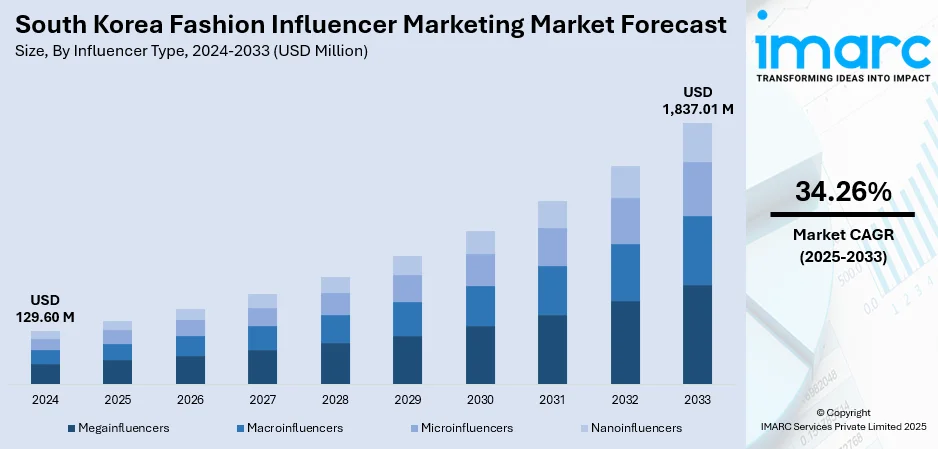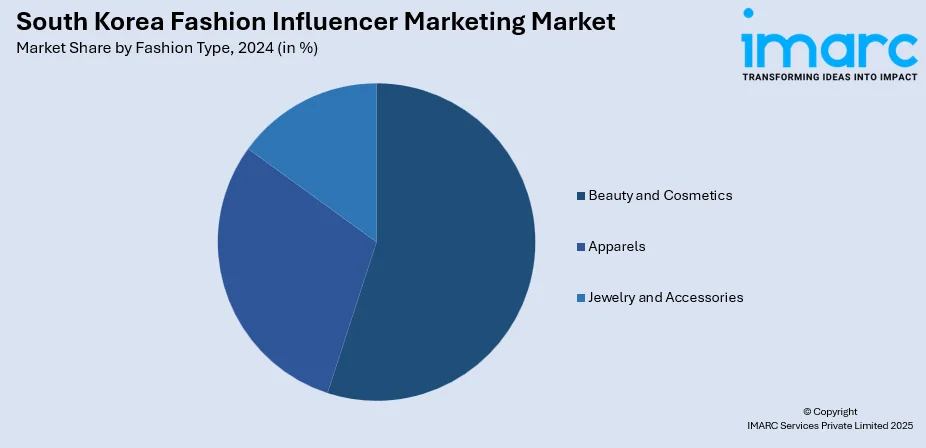
South Korea Fashion Influencer Marketing Market Size, Share, Trends and Forecast by Influencer Type, Fashion Type, and Region, 2025-2033
South Korea Fashion Influencer Marketing Market Overview:
The South Korea fashion influencer marketing market size reached USD 129.60 Million in 2024. The market is projected to reach USD 1,837.01 Million by 2033, exhibiting a growth rate (CAGR) of 34.26% during 2025-2033. The market has strong momentum, with the growing influence of online platforms in dictating consumer trends. Brands are using a broad spectrum of influencer categories from mega to micro to advocate several fashion segments such as streetwear, luxury, and environmentally responsible apparel. Regional tastes and fashion subcultural trends also significantly inform campaign agendas. As the market changes with shifting trends and consumer patterns, brands are aggressively looking for opportunities to grow their South Korea fashion influencer marketing market share.
|
Report Attribute
|
Key Statistics
|
|---|---|
|
Base Year
|
2024
|
|
Forecast Years
|
2025-2033
|
|
Historical Years
|
2019-2024
|
| Market Size in 2024 | USD 129.60 Million |
| Market Forecast in 2033 | USD 1,837.01 Million |
| Market Growth Rate 2025-2033 | 34.26% |
South Korea Fashion Influencer Marketing Market Trends:
Strategic AI and Augmented Reality Integration
In January 2025, the South Korean fashion influencer marketing scene adopted AI and augmented reality (AR) to maximize campaign performance. Influencers are using AI analytics increasingly to select collaborations, forecast engagement, and maximize return on investment. At the same time, AR technologies allow virtual try-on and interactive product experiences through the influencers' portals themselves, engaging consumers at a deeper level and driving purchase intent. This convergence of technology enables brands to understand their audience more intimately, personalize communication, and monitor performance with unprecedented precision.. It is revolutionizing campaign planning and execution to make campaigns more efficient and highly tailored.. Influencers also benefit, by leveraging these tools to present products differently, rendering them more attractive. This transition into advanced digital integration is a turning point in the marketing strategy, keeping South Korea's influencer market competitive even during an over-saturated market. With increased applications of AI and AR, the market is witnessing data-oriented, interactive campaigns which resonate highly with consumers. This transition is one of the major forces propelling today's South Korea fashion influencer marketing market growth.

To get more information on this market, Request Sample
Rise of Micro and Nano Influencers
In March 2024, South Korea’s influencer marketing experienced a notable shift toward micro and nano influencers, reflecting a broader industry trend. These smaller influencers tend to build more authentic and engaged trust and relatability over broad popularity. Brands have responded by creating more personalized, credible campaigns tailored to these niche followings. This approach encourages stronger loyalty and better customer engagement compared to traditional celebrity partnerships. Companies now diversify their influencer mixes, investing in grassroots voices that deliver impactful results in a cost-effective way. By embracing micro and nano influencers, marketers tap into new consumer segments with highly engaged communities, generating organic and meaningful interactions. This trend signals a more targeted strategic approach and a move away from broad mass-market appeals. The growing importance of these influencers highlights a significant shift in how brands connect with consumers. Overall, this development is a defining factor in the South Korea fashion influencer marketing market trends, emphasizing authenticity and audience relevance.
Celebrity and K‑Pop Influence
A top K‑Pop idol modeled major global runway shows in December 2024, demonstrating exactly how fashion campaigns are increasingly incorporating pop‑culture icons into their marketing mix. Such a shift mirrors a wider trend: brands are tapping into the massive reach and emotional resonance these stars command, both locally and internationally. K‑Pop idols build passionate, attached fanbases that obsess over their every step, and they make compelling messengers for brands. As such celebrities step onto international fashion stages, they bring brand visibility and cultural relevance. This is more than mere endorsement. K-Pop personalities are now heavily integrated into campaign storytelling, mixing entertainment, fashion, and narrative to create strong brand personas. The result is a harmonious hybridization of culture and commerce, where fan loyalty is converted into brand loyalty. This strategy not only increases sales but also increases brand prestige and relevance. In total, the increasing partnership between fashion brands and K‑Pop stars is a key driver of evolving marketing dynamics and is still a leading catalyst behind continuous changes and expansion.
South Korea Fashion Influencer Marketing Market Segmentation:
IMARC Group provides an analysis of the key trends in each segment of the market, along with forecasts at the country and regional levels for 2025-2033. Our report has categorized the market based on influencer type and fashion type.
Influencer Type Insights:
- Megainfluencers
- Macroinfluencers
- Microinfluencers
- Nanoinfluencers
The report has provided a detailed breakup and analysis of the market based on the influencer type. This includes megainfluencers, macroinfluencers, microinfluencers, and nanoinfluencers.
Fashion Type Insights:

- Beauty and Cosmetics
- Apparels
- Jewelry and Accessories
A detailed breakup and analysis of the market based on the fashion type have also been provided in the report. This includes beauty and cosmetics, apparels, and jewelry and accessories.
Regional Insights:
- Seoul Capital Area
- Yeongnam (Southeastern Region)
- Honam (Southwestern Region)
- Hoseo (Central Region)
- Others
The report has also provided a comprehensive analysis of all the major regional markets, which include the Seoul Capital Area, Yeongnam (Southeastern Region), Honam (Southwestern Region), Hoseo (Central Region), and others.
Competitive Landscape:
The market research report has also provided a comprehensive analysis of the competitive landscape. Competitive analysis such as market structure, key player positioning, top winning strategies, competitive dashboard, and company evaluation quadrant has been covered in the report. Also, detailed profiles of all major companies have been provided.
South Korea Fashion Influencer Marketing Market News:
- February 2025: InterAd, a Seoul-based digital marketing firm, underscores the increasing importance of Naver Blog in South Korean influencer marketing. With Naver having more than half of the search engine market share in the country, its cross-platform provides brands with a singular chance to reach Korean consumers through genuine, rich content. The platform's vertical communities provide targeted messaging across multiple subcultures of fashion, increasing engagement and credibility. InterAd focuses on the significance of using Naver's tools to find and partner with influencers who connect with targeted audiences.
South Korea Fashion Influencer Marketing Market Report Coverage:
| Report Features | Details |
|---|---|
| Base Year of the Analysis | 2024 |
| Historical Period | 2019-2024 |
| Forecast Period | 2025-2033 |
| Units | Million USD |
| Scope of the Report |
Exploration of Historical Trends and Market Outlook, Industry Catalysts and Challenges, Segment-Wise Historical and Future Market Assessment:
|
| Influencer Types Covered | Megainfluencers, Macroinfluencers, Microinfluencers, Nanoinfluencers |
| Fashion Types Covered | Beauty and Cosmetics, Apparels, Jewelry and Accessories |
| Regions Covered | Seoul Capital Area, Yeongnam (Southeastern Region), Honam (Southwestern Region), Hoseo (Central Region), Others |
| Customization Scope | 10% Free Customization |
| Post-Sale Analyst Support | 10-12 Weeks |
| Delivery Format | PDF and Excel through Email (We can also provide the editable version of the report in PPT/Word format on special request) |
Key Questions Answered in This Report:
- How has the South Korea fashion influencer marketing market performed so far and how will it perform in the coming years?
- What is the breakup of the South Korea fashion influencer marketing market on the basis of influencer type?
- What is the breakup of the South Korea fashion influencer marketing market on the basis of fashion type?
- What is the breakup of the South Korea fashion influencer marketing market on the basis of region?
- What are the various stages in the value chain of the South Korea fashion influencer marketing market?
- What are the key driving factors and challenges in the South Korea fashion influencer marketing market?
- What is the structure of the South Korea fashion influencer marketing market and who are the key players?
- What is the degree of competition in the South Korea fashion influencer marketing market?
Key Benefits for Stakeholders:
- IMARC’s industry report offers a comprehensive quantitative analysis of various market segments, historical and current market trends, market forecasts, and dynamics of the South Korea fashion influencer marketing market from 2019-2033.
- The research report provides the latest information on the market drivers, challenges, and opportunities in the South Korea fashion influencer marketing market.
- Porter's five forces analysis assist stakeholders in assessing the impact of new entrants, competitive rivalry, supplier power, buyer power, and the threat of substitution. It helps stakeholders to analyze the level of competition within the South Korea fashion influencer marketing industry and its attractiveness.
- Competitive landscape allows stakeholders to understand their competitive environment and provides an insight into the current positions of key players in the market.
Need more help?
- Speak to our experienced analysts for insights on the current market scenarios.
- Include additional segments and countries to customize the report as per your requirement.
- Gain an unparalleled competitive advantage in your domain by understanding how to utilize the report and positively impacting your operations and revenue.
- For further assistance, please connect with our analysts.
 Request Customization
Request Customization
 Speak to an Analyst
Speak to an Analyst
 Request Brochure
Request Brochure
 Inquire Before Buying
Inquire Before Buying




.webp)




.webp)












